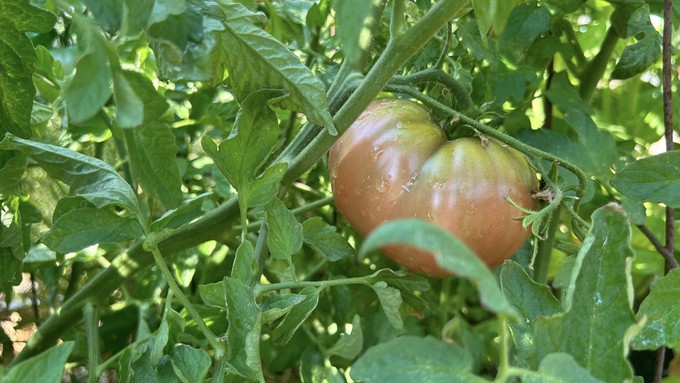
Relief from triple-digit temperatures coming this weekend, but smoky skies may linger

A Cherokee Carbon tomato ripens on the vine. Because of wildfire particulate in the air, tomatoes may develop a smoky taint. Kathy Morrison
Sacramento’s forecast high for Saturday (July 27): 82 degrees. That’s 20 degrees cooler than last weekend – and most of this month.
So far, July is trending to be one of the hottest months on record – not just in Sacramento, but worldwide. Monday (July 22) went down as the hottest day in recorded human history, European climatologists reported this week.https://apnews.com/article/hottest-day-ever-climate-change-weather-heat-extreme-global-warming-8e2b0b7fa0360ecb931ca333a832c694
Sacramento has been doing its part. Through July 25, Sacramento highs have averaged 101 degrees – that’s more than eight degrees above normal (92.6) for July. Helping hold in that heat were unusually warm nights; lows averaged 65 degrees, about six degrees above normal.
This intense heat dried vegetation to a crisp, especially grasses; that’s created high fire danger throughout Northern California. With abundant fuel, the Park Fire in Butte County doubled in size in less than 24 hours, growing to more than 164,000 acres – an area larger than the city of Chicago.
Smoke from that blaze is drifting across the valley and foothills, dropping ash and polluting air. That can trigger breathing problems for people with sensitivities as well as burn eyes.
All this heat and smoke can have major effects on our summer gardens, too. Expect to see some ozone damage to foliage. Smoky skies tend to cut down on bee activity, too. Tomatoes and grapes may develop smoke taint to their flavor. Make sure to wash fruit and vegetables well before eating; soot and ash can cling to their skin or leaves.
With such high fire danger, just a spark can start a catastrophe, warns the weather service. Do not use power equipment outdoors; a lawn mower or edger hitting a rock may be all it takes to cause a blaze. Likewise, don’t park vehicles on dry grass; igniting an engine also can ignite a grass fire.
Cooler conditions starting Saturday will help relieve that fire danger. In fact, the weather service predicts no more triple-digit temperatures for the rest of July – and August starts Thursday.
For more weather updates: https://www.weather.gov/sto/.
Comments
0 comments have been posted.Sacramento Digs Gardening to your inbox.
Food in My Back Yard Series
May 6: Maintain soil moisture with mulch for garden success
April 29: What's (already) wrong with my tomato plants?
April 22: Should you stock up on fertilizer? (Yes!)
April 15: Grow culinary herbs in containers
April 8: When to plant summer vegetables
April 1: Don't be fooled by these garden myths
March 25: Fertilizer tips: How to 'feed' your vegetables for healthy growth
March 18: Time to give vegetable seedlings some more space
March 11: Ways to win the fight against weeds
March 4: Potatoes from the garden
Feb. 25: Plant a fruit tree now -- for later
Feb. 18: How to squeeze more food into less space
Feb. 11: When to plant? Consider staggering your transplants
Feb. 4: Starting in seed starting
Sites We Like
Garden Checklist for week of May 11
Make the most of the lower temperatures early in the week. We’ll be back in the 80s by Thursday.
* Plant, plant, plant! It’s prime planting season in the Sacramento area. Time to set out those tomato transplants along with peppers and eggplants. Pinch off any flowers on new transplants to make them concentrate on establishing roots instead of setting premature fruit.
* Direct-seed melons, cucumbers, summer squash, corn, radishes, pumpkins and annual herbs such as basil.
* Harvest cabbage, lettuce, peas and green onions.
* In the flower garden, direct-seed sunflowers, cosmos, salvia, zinnias, marigolds, celosia and asters. (You also can transplant seedlings for many of the same flowers.)
* Plant dahlia tubers.
* Transplant petunias, marigolds and perennial flowers such as astilbe, columbine, coneflowers, coreopsis, dahlias, rudbeckia and verbena.
* Keep an eye out for slugs, snails, earwigs and aphids that want to dine on tender new growth.
* Feed summer bloomers with a balanced fertilizer.
* For continued bloom, cut off spent flowers on roses as well as other flowering plants.
* Add mulch to the garden to maintain moisture. Mulch also cuts down on weeds. But don’t let it mound around the stems or trunks of trees or shrubs. Leave about a 6-inch-to-1-foot circle to avoid crown rot or other problems.
* Remember to weed! Pull those nasties before they set seed.
* Water early in the day and keep seedlings evenly moist.